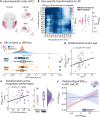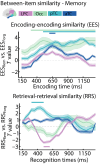Reinstatement and transformation of memory traces for recognition
- PMID: 39970226
- PMCID: PMC11838014
- DOI: 10.1126/sciadv.adp9336
Reinstatement and transformation of memory traces for recognition
Abstract
Episodic memory relies on the formation and retrieval of content-specific memory traces. In addition to their veridical reactivation, previous studies have indicated that traces may undergo substantial transformations. However, the exact time course and regional distribution of reinstatement and transformation during recognition memory have remained unclear. We applied representational similarity analysis to human intracranial electroencephalography to track the spatiotemporal dynamics underlying the reinstatement and transformation of memory traces. Specifically, we examined how reinstatement and transformation of item-specific representations across occipital, ventral visual, and lateral parietal cortices contribute to successful memory formation and recognition. Our findings suggest that reinstatement in temporal cortex and transformation in parietal cortex coexist and provide complementary strategies for recognition. Further, we find that generalization and differentiation of neural representations contribute to memory and probe memory-specific correspondence with deep neural network (DNN) model features. Our results suggest that memory formation is particularly supported by generalized and mnemonic representational formats beyond the visual features of a DNN.
Figures






References
-
- R. Semon, (1921). The Mneme. (London: Allen, 1921).
-
- Squire L. R., Zola-Morgan S., The medial temporal lobe memory system. Science 253, 1380–1386 (1991). - PubMed

